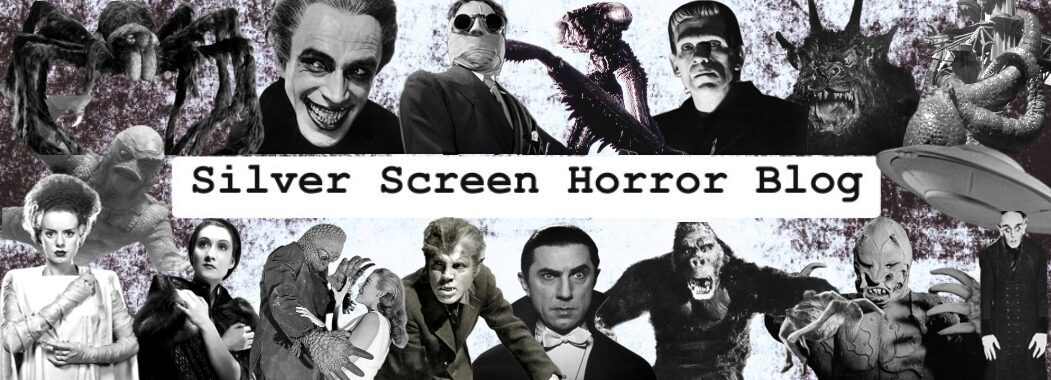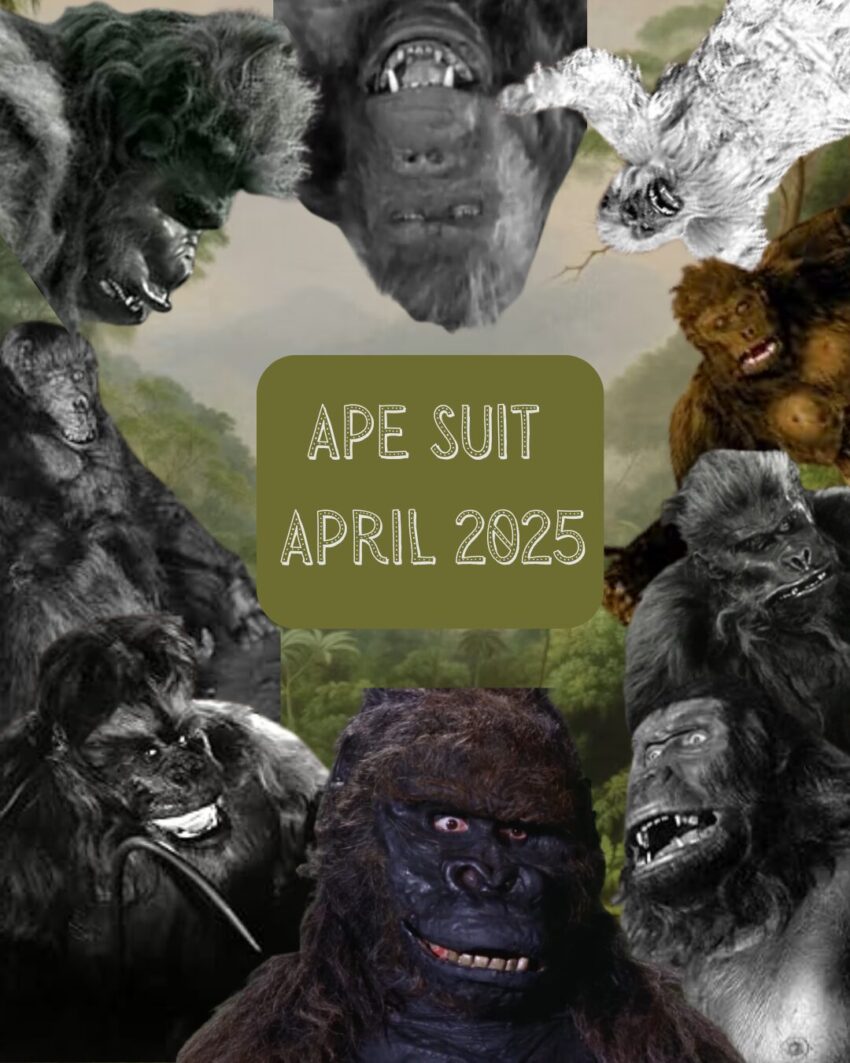
I’m pleased to announce this blog’s first annual celebration of Ape Suit April* in honor of the many classic horror movies that occupy one of my absolute favorite niche horror subgenres: man in a full-body gorilla suit movies. These very special films were pumped out by major studios and poverty row studios alike at a delightful – and quite frankly befuddling – rate during the 1930s, ‘40s, and ‘50s. I will spend the month of April discussing these films and attempting to convince you that they’re actually fairly significant in the history of horror. But before I introduce our first film, I wanted to answer the question that I imagine is top of mind for most readers: what’s up with all the gorilla movies in Golden Age Hollywood?
Aristotle philosophized that the only characteristic that separated humans from animals was our ability to rationalize. The idea of a human-animal binary survived centuries of philosophy, until Europeans “discovered” the gorilla in 1847 in Liberia. The existence of animals which physically resembled humans was undoubtedly unsettling for a society that took great pride and comfort in their superior status over animals, which were, according to Descartes, nothing more than non-sentient automata incapable of thought or feelings. The existence of gorillas sparked doubt and fear in European minds about what it means to be human.
The discovery of gorillas also sparked curiosity, as in the 1850s European museums rushed to acquire and display stuffed gorilla specimens for a fascinated yet apprehensive public. In 1859, Darwin’s theory of evolution sparked even more interest in just how closely related humans were to gorillas. His work laid the groundwork for understanding humans’ place in the evolutionary process, positing that species evolved as a result of natural selection. It wouldn’t be until 1871 that he specifically proposed that humans and apes share a common ancestor in his book The Descent of Man.
The same year that Darwin published On the Origin of Species, French artist Emmanuel Frémiet unveiled his sculpture Gorille enlevant une négresse (Gorilla carrying off a Negress) at the Paris Salon. It depicted a female gorilla dragging away a woman, and is accordingly inscribed with the words “Gorille Femelle” (female gorilla). Although he was just about as clear as possible as to the sex of the gorilla, observers still read the ape as male, adding to the perceived danger posed by the gorilla the threat of sexual violence or necrophilia. The sculpture was not well-received; in fact, it was deemed morally reprehensible and rejected by the Salon. Frémiet said the following about the response to his work:
“At a time when a lot of noise was being made about mankind and apes being brothers, it was an audacious idea; and my work proved even more aggravating since, the gorilla being the ugliest of all the primates, the comparison was hardly flattering for humans. With great recklessness, this gorilla was dragging off a young woman. Since the young woman in question was a Negress, I thought my gorilla might pass. This was not to be. The jury’s condemnation was unanimous. My work was declared to be seriously offensive to public morality, and it was banished pitilessly from the Salon.“
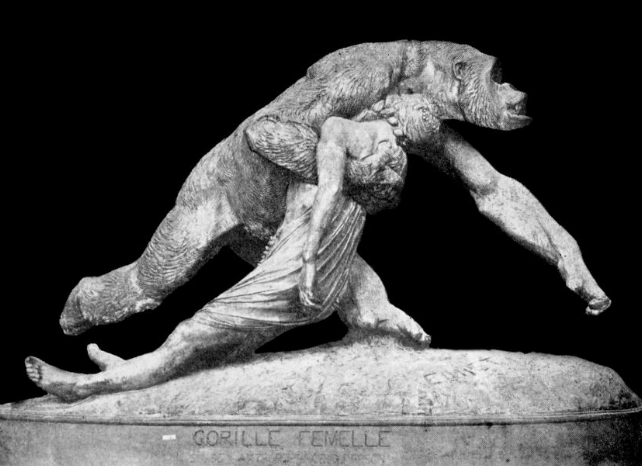
We’ll discuss racism and ape movies in greater detail later this month – the topic deserves its own blog post.
Frémiet sculpted another life-sized ape dragging away a woman in 1887 with his work Gorilla carrying off a woman. The reception this time was much more positive – his sculpture received the Salon’s Medal of Honor. There are differences between this later entry and his 1859 work. This woman is white, alive, and captured by a male gorilla. He holds her in one arm and a stone in another, with an arrow piercing his shoulder. It looks as though he is fending off an attack by the woman’s companions and is attempting to steal her away as a prize. Rape is still heavily implied.
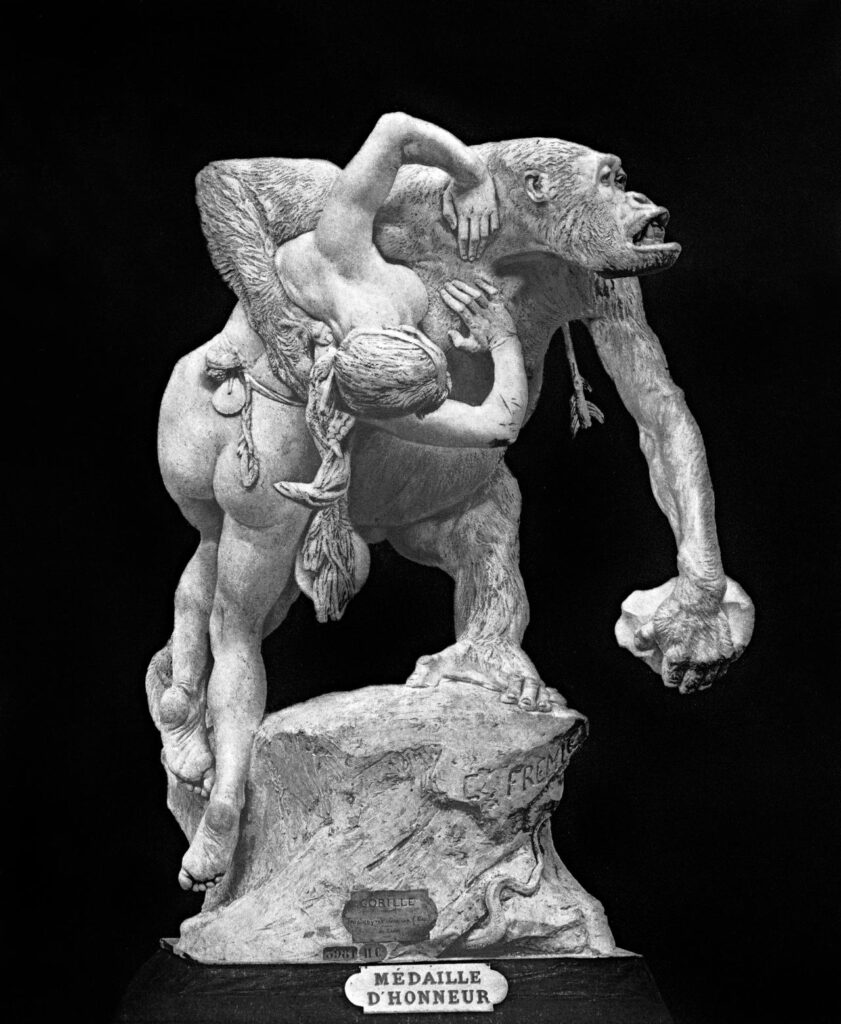
I bring up Frémiet’s works because they should look familiar to fans of classic horror. Posters for gorilla suit movies frequently feature vicious apes absconding with helpless maidens stolen from the arms of human men. It’s difficult to imagine that these posters weren’t directly inspired by Frémiet’s ape scenes.
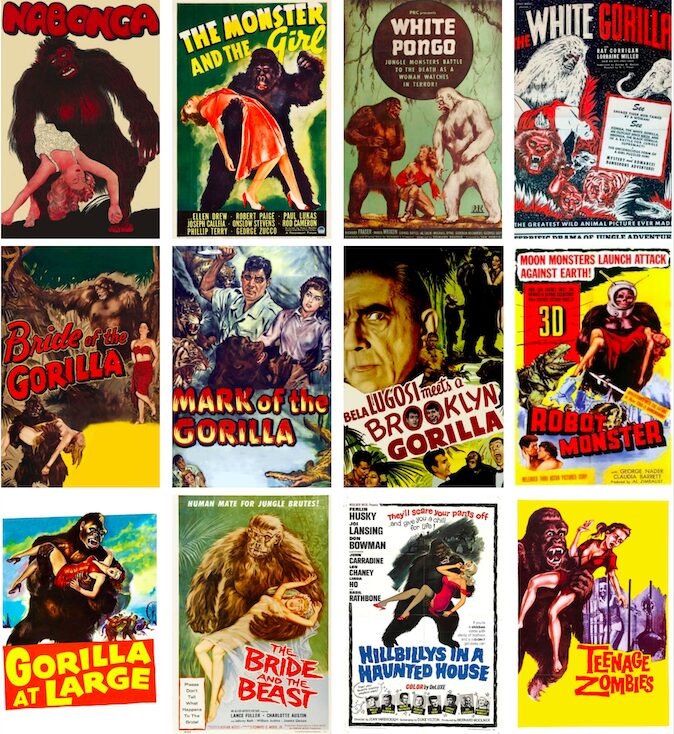
In spite of the keen interest in gorillas during the 19th century, the first reliable field study of mountain gorillas would not be conducted until 1959 – a whole century after the initial European discovery of their existence. It’s important to understand that this lack of knowledge most certainly fueled the discomfort and fear of the general public toward apes. I imagine that fear of the unknown, along with the philosophical crisis presented by Darwin’s theory of evolution and the sensationalist portrayal of gorillas as kidnappers and rapists of human women, all contributed to the presence of apes in horror movies on the silver screen.
There are plenty of horror films which involve a menagerie of different animal threats, including sharks, birds, alligators, killer shrews, spiders, and giant leeches. But ape movies are the only animal horror films that capitalized on the existential dread which accompanied the challenging of the Cartesian human-animal binary. Not to mention the additional anxieties induced by Freud’s theory of animal phobia. In his theory, he postulates that sexual desires for a parent become displaced onto a vicious animal. It’s not a far stretch to say this theory is reflected in the gorilla horror movies of early Hollywood, though perhaps most notably in Ed Wood’s The Bride and the Beast (1958) – stay tuned for more on this particular movie.
All this is to say what I repeat ad nauseam to all who will listen: horror is a mirror. It reflects the fears of society at a given moment. It’s social commentary. It’s deeply political. And ape suit horror is no different – which is why I absolutely love this horror subgenre. Over the course of the month, I will do my best to convince you of its merit too.
I’ll be back very soon with my first film review. Until then, may your April be hominoid, bipedal, and kind of creepy, in an uncanny valley sort of way.
*Disclaimer: For the month of April, I will use the terms “ape” and “gorilla” interchangeably. I am aware that “ape” refers to a broad category of primates belonging to the Hominoidea family, while “gorilla” is a specific genus within that family. I’ve decided upon the name Ape Suit April for two reasons: (1) not all ape suits resemble gorillas – some resemble other genus within the Hominoidea family (i.e., orangutans, chimpanzees, bonobos) and (2) alliteration.
